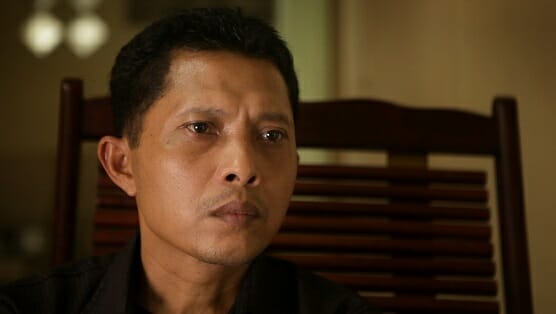The Look of Silence is the companion piece to director Joshua Oppenheimer’s 2012 Academy Award-nominated documentary, The Act of Killing,which examined the Indonesian genocide of 1965-66 through interviews and on-camera recreations by the military perpetrators. This time around, the film focuses on a family of survivors whose youngest son seeks the truth of his brother’s death during the culling.
While the first film was more visually inventive and, to an extent, playful, The Look of Silence, with its straightforward storytelling, is devastatingly powerful. The film is an elegiac and beautiful—yet horrifying—work. Numerous moments feel like a kick in the gut. (There’s no roundabout way to describe the visceral reaction to its imagery and dialogue.) If The Act of Killing didn’t convince audiences of Oppenheimer’s mastery as a filmmaker and documentarian, then The Look of Silence surely will.
Oppenheimer makes no pretense to remain objective. The film is a damning critique of the mass murderers of more than 1 million people who were deemed “communists” or intellectuals. In other words, the military gangs that rose to power exterminated anyone who dared oppose them.
The film introduces audiences to Adi, an optometrist, born after the killings. His mother Rohani and his invalid father Rukun (both centenarians) lost a son, Ramli, in the genocide. Rohani tells Adi that she and Rukun rejoiced at his birth because he was Ramli’s replacement and their reason to continue living. This birthright would be difficult for anyone to bear, but rather than a burden, the ghost of the elder brother he never met proves to be a badge of courage, empowering Adi to seek the truth. Ramli is a martyr, a symbol for victims whose stories are never told or remain unknown.
The film opens with a haunting close-up of an older man in odd glasses. The colorful specs turn out to be Adi’s instrument that tests patients’ eyes, and the man wearing the glasses is one of the death squad leaders. It’s a scene that recurs throughout the film—Oppenheimer’s use of stunning color and repetitive shots creates a beautiful backdrop, or a palate cleanser, for the horrific subject matter. Adi meets with the men responsible for his brother’s death under the guise of a medical appointment. Like Anwar Congo, the main character in The Act of Killing, the perpetrators are open to being filmed while answering questions from Adi or Oppenheimer. In fact, many of the men are only too gleeful, happy to take center stage on camera, boasting about their murderous exploits. It’s nearly unfathomable.
In one scene, which Oppenheimer has said served as the jumping-off point for the two companion films, the audience watches two former death squad leaders—who had never met—tell similar stories of killing the communists at the banks of the Snake River in North Sumatra. More than 10,000 people died at the river, and the men clearly describe the smell and sight of blood, and how prisoners struggled or begged for their lives. The encounter ends with a staggering shot of the men posing for pictures with each other, arms around each other’s necks, brothers-in-arms without remorse for their actions. If there were tearful apologies by those who participated in the killings, like we’ve seen in many documentaries about other genocides, Oppenheimer doesn’t show us.
The retelling of conquests happens with almost rote repetition from various killers associated with Ramli’s death. Many times the men share their stories in front of their own families, who say they never knew the details of their husbands’/fathers’ roles in the genocide. At the start of one visit, a woman proudly introduces her father to Adi, but when she hears Adi’s side of the story, her face dissolves into confusion. It’s later mixed with disgust as her father talks about taking blood from the throat of a communist and drinking it as a preventative measure to keep from going insane. Another leader nonchalantly describes the taste of human blood as both “salty and sweet.” Oppenheimer’s camera often lingers at the end of many scenes, allowing the silence to speak volumes.
In direct contrast to the perpetrators, many of whom enjoy comfortable lives and remain in power, the survivors won’t—or can’t—discuss the genocide. They want to forget the past, or they continue to fear for their families’ lives. (The killers and victims’ families often still live side by side in the same villages where the murders occurred.) Adi’s calm, quiet demeanor—even when he watches footage of people describing his brother’s death in detail—somehow disarms his enemies. His approach is one of sadness and not vengeance, and allows for probing questions.
That’s not to say the past is water under the bridge for the interviewers and their subjects. Cameras capture both veiled and direct threats from death squad leaders who tell Adi and Oppenheimer to stop asking so many questions. These men are still in power, and we can’t help but wonder about the safety of Adi, his elderly parents, or his young family. Just as disconcerting are the end credits, with many roles and backers of the film attributed to “Anonymous.”
Through his powerful works, Oppenheimer shows how living in fear continues in Indonesia—and that the world’s collective silence makes us all complicit.
Director: Joshua Oppenheimer
Writer: Joshua Oppenheimer
Release Date: Opens July 17 in New York, July 24 in Los Angeles with other cities to follow.
Christine N. Ziemba is a Los Angeles-based freelance pop culture writer and regular contributor to Paste. You can follow her on Twitter.
